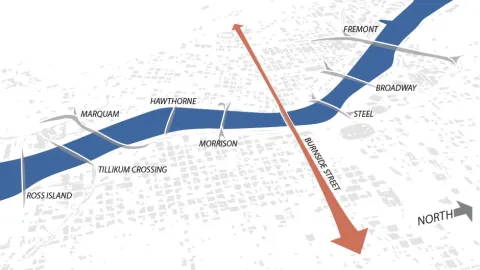
What is a lifeline route?
A lifeline route is a route that allows emergency services to respond after a major earthquake or other disaster. Afterwards, it remains open to support emergency response and recovery.
A lifeline route will maintain access to fire stations, hospitals and other emergency services right after a quake. This will allow first responders to get where they’re needed. After that, it will allow for food, water, medical supplies and other necessities to be brought in. It will also allow people to be evacuated to unaffected areas.
In the longer term, a lifeline route will support rebuilding after a disaster by allowing movement of people and freight to where they are needed.
What makes the Burnside a lifeline route?
Metro declared all of Burnside Street a regional lifeline route in 1996, including the Burnside Bridge. Burnside Street (sometimes Burnside Road) runs almost 19 miles, from the Washington County line in the west to Mount Hood Highway (US 26) in the east.
Burnside Street was chosen because it had the fewest risks of having overpasses collapse on it during an earthquake.
The machinery that opens the Burnside is simpler and better protected than other movable Willamette River bridges. There are also no freeway ramps that could collapse onto the bridge. The Morrison Bridge is similar to the Burnside in how its drawbridge works, but the Morrison is in danger of the I-5 ramps above it collapsing onto the bridge in an earthquake.
What are we doing to keep the lifeline route open?
In 2002, we installed installed seismic restraints to keep some Burnside Bridge sections from coming apart in an earthquake.
The Earthquake Ready Burnside Bridge project will replace the existing bridge with a new bridge built to a high seismic standard. Read about the Preferred Alternative for the new bridge here.
